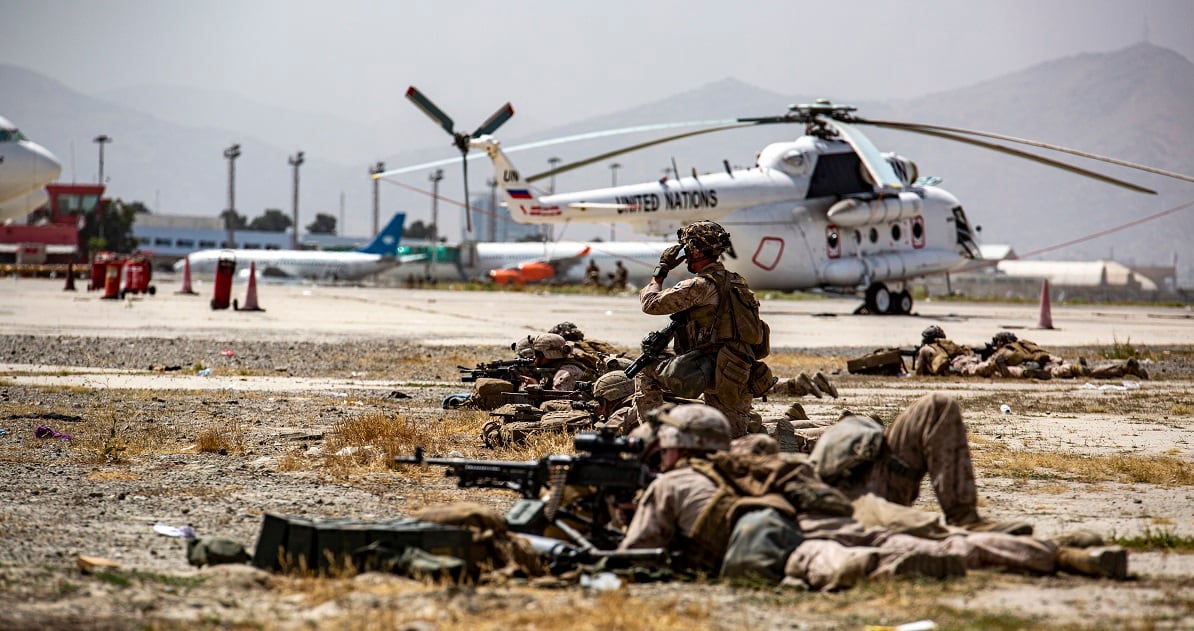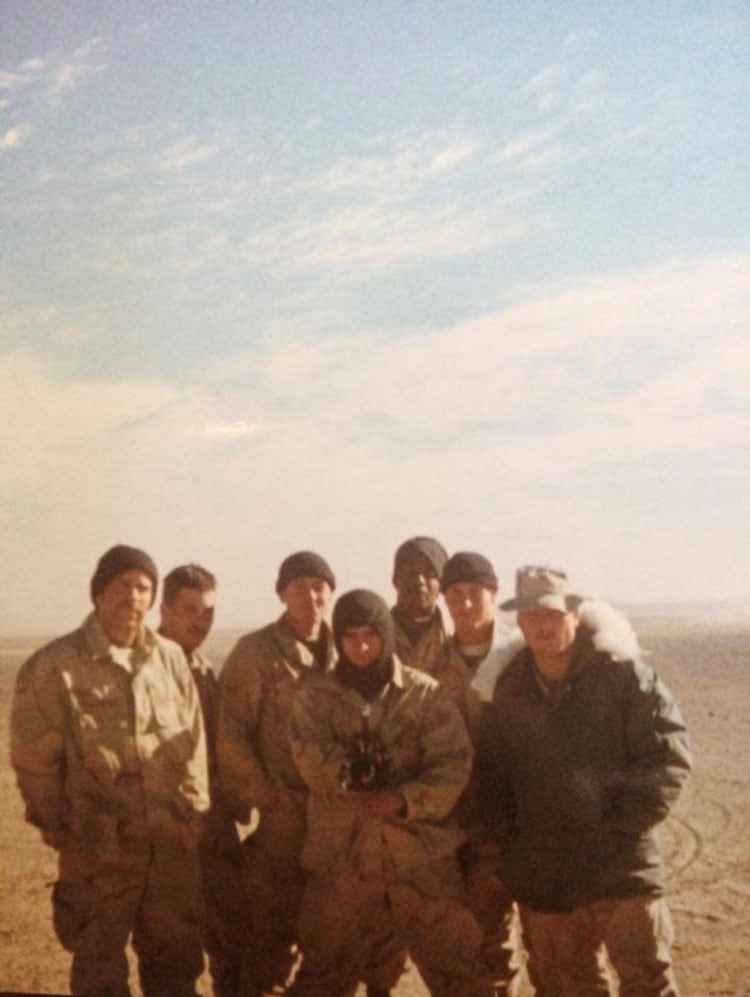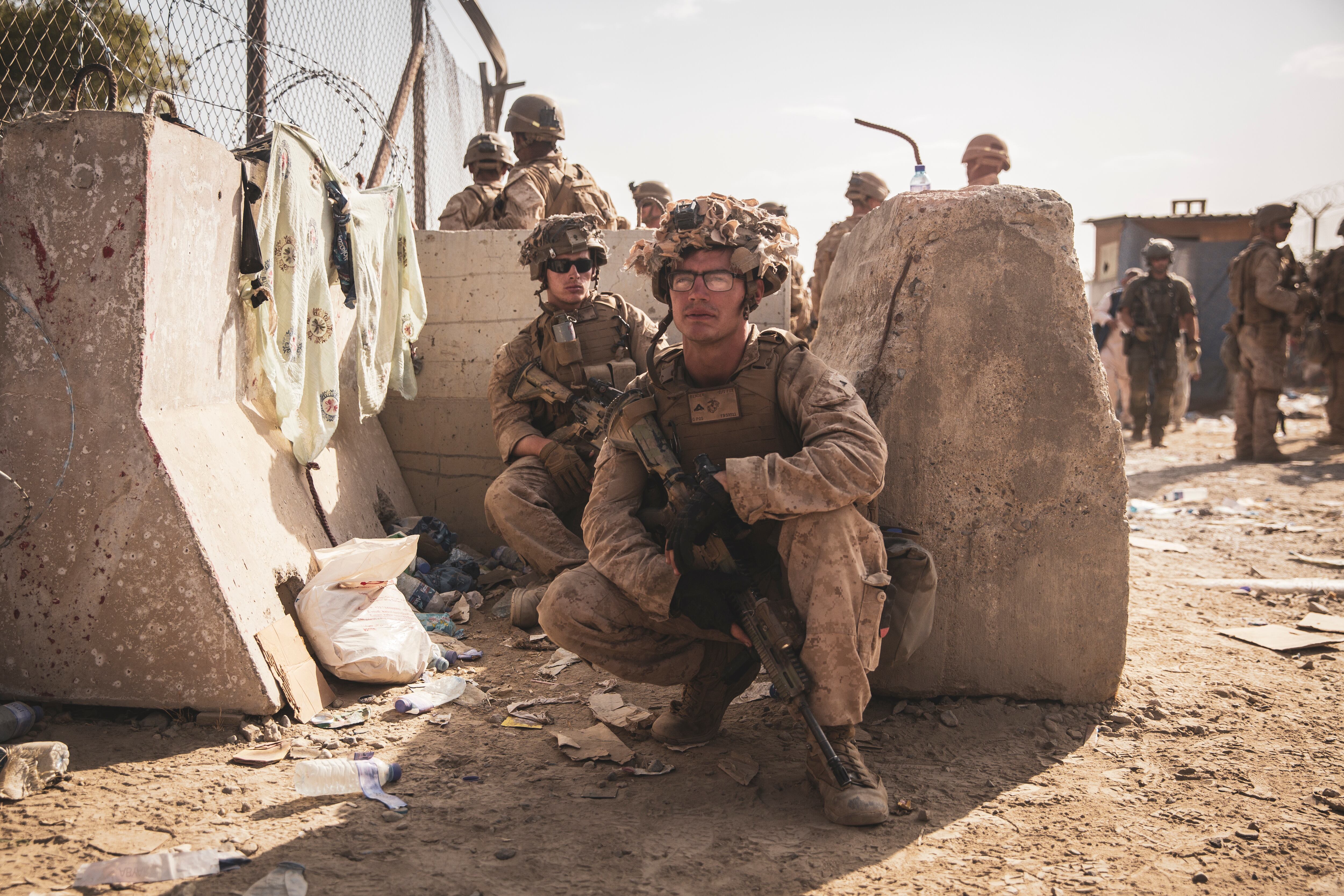On Sept. 11, 2001, the 15th Marine Expeditionary Unit was at port in Darwin, Australia.
Most of the Marines were out enjoying their first day of liberty after training alongside the Australia military, when suddenly the entire world changed.
“Everyone get back to the ship — we’re going to war,” retired sergeant major James Roberts said he remembers hearing as he was enjoying his first day of liberty at a bar in Darwin, Australia.
He did not believe the message until someone turned on the television and they saw a plane fly into the Pentagon.
RELATED

The Marines on that MEU were the first conventional troops to land in Afghanistan, tasked with securing Camp Rhino, a small airfield just south of Kandahar, Afghanistan, where more U.S. troops flew in as the invasion force was gathered then sent into the nation.
Twenty years later, roughly 1,200 Marines with the 24th MEU were once again in Afghanistan defending a runway, but this time the mission was different.
Joining the MEU Marines were roughly 50 Marines from Task Force 51/5, based out of Bahrain, and about 800 Marines from the Special Purpose Marine Air-Ground Task Force–Crisis Response–Central Command.
The MEU sent in Battalion Landing Team 1/8 along with Combat Logistics Battalion 24 to help secure the airport and process evacuees as U.S. troops were withdrawing from the country they had been in for nearly 20 years.
The MEU was first unit sent to Hamid Karzai International Airport as the Taliban rushed across the nation, John Kirby had said in August.
After the 24th MEU set up a defensive line at the Kabul airport, those Marines were joined by 800 Marines from Special Purpose Marine Air-Ground Task Force–Crisis Response–Central Command and elements of the Army’s 82nd Airborne Division.
Expeditionary mindset
The MEUs provide the U.S. military with a unique capability unmatched by any other service.
“It’s a validation of the Marine Corps’ multidecade argument that the Marine Expeditionary Unit is a viable middle-weight force” Dakota Wood, a Marine veteran and senior research fellow at the conservative think tank The Heritage Foundation, told Marine Corps Times.
Wood said the Army, with its airborne units, has a very good lightweight force capable of sneaking into an area, while their more conventional forces provide an extremely heavy punch.
But the staying power of the lightweight force can be lacking compared to the MEU, while the heavy Army units require either long land routes or a runway to get to its destination.
The middleweight force provided by the MEU is ideal for capturing and securing an airfield when invading a region and slowly building up a presence, like in 2001 with the 15th MEU.
When leaving a lost war, the MEU is able to hold onto the final runway while people and equipment evacuate, before taking off itself on the last flight out, Wood said.
But beyond the capability the Corps simply has an expeditionary culture that has been instilled in the Corps’ history from the Spanish-American War to the Banana wars through World War II and now Afghanistan.
“These are the war stories that are passed down from one generation to the next, they’re the experiences that are shared as Marines go through boot camp and young officers are getting their training … overtime it creates a culture or cultural mindset within the service,” Wood said.
The lineage was present when Marines invaded Afghanistan.
Roberts, who enlisted in 1986, said his first platoon sergeant was a “tunnel rat” in Vietnam.
On March 8, 1965, the 9th Marine Expeditionary Brigade landed in Da Nang, Vietnam ― becoming the first battalion size element to deploy to the nation.
A decade later as the military desperately evacuated the U.S. Embassy in Saigon two Marines, Cpl. Charles McMahon Jr. and Lance Cpl. Darwin Judge, became the last two casualties of the Vietnam War when they were hit by a Viet Cong rocket attack.
The platoon sergeant shared numerous stories with Roberts and the Marines he grew up with as they were stating their careers.
On the MEU in 2001
After watching the events of Sept. 11, 2001, unfold on televisions on bars and on ship, the Marines of the 15th MEU knew they were going to war.
It was just a matter of when and where.
“We wanted payback, that was the initial thought we wanted to go kick somebody’s ass,” retired Gunnery Sgt. Jason Whipkey told Marine Corps Times in a phone interview.
Whipkey, a former 0351-infantry assault Marine, was a 27-year-old corporal assigned as a squad leader with the 15th MEU in 2001.
But on its way to the MEU made one stop in what was then known as East-Timor as part of a humanitarian mission, another staple of the MEUs across the years.
After the humanitarian mission and a brief stop securing an airfield in Pakistan for the Air Force, the MEU was finally ready to invade Afghanistan.
Roberts said the rush of knowing they were going to war was quickly followed by a lull as the Marines slowly traveled to get into position for the invasion.
The retired sergeant major was a staff sergeant in 2001, serving as the platoon sergeant for 1st Battalion, 1st Marines, scout sniper platoon.
Members of the CIA and special operation forces had been in the country for months, but as of Nov. 25, 2001, no conventional U.S. forces had set foot in the nation.
That all changed when 1st Battalion, 1st Marines, loaded up on CH-53E Super Stallions and departed the amphibious assault ship Peleliu in the early afternoon, prepared to fly more than 400 miles from the ship into Afghanistan and capture the runway.
Whipkey, riding in the back of one of the Super Stallions, says he watched the aerial refueling the helicopter needed to make it to Afghanistan.
“It was kind of scary, kind of cool, definitely got the adrenaline running,” Whipkey said.
Eventually the helicopters touched down at objective Rhino and the Marines rushed out of their helicopters as the conventional invasion of the country began.
“We all were jockeying to be on that first HELO that touched down,” Whipkey said.
“I honestly think we did touchdown first … but to actually put my feet on the ground in Afghanistan it was early,” he added.
Though Roberts was not on that initial wave of helicopters to touch down on Camp Rhino, the veteran of Desert Storm was still nervous as he was flying to war for the second time.
“I had been to Desert Storm so I was somewhat familiar with a combat environment, but it still didn’t make it any better it was still that nervousness that everyone gets,” he said.
“But then once we got there and we got set up … my guys did an outstanding job.”
Conditions at Camp Rhino were rough, and the MEU had deployed to the nation in winter without the proper cold-weather gear, Whipkey said.
Eventually some members of the Air Force donated a few parkas to the Marines, which they would pass around to help everyone stay warm, he added.

Though cold-weather gear was not needed at the Kabul airport in 2021, conditions were likely not much better than those in the early days of the war, Brig. Gen. Peter D. Huntley, director of the operations division for Marine plans, policies and operations, told reporters.
“It’s not dissimilar to when the MEUs went ashore at the beginning of this involvement in Afghanistan, and they landed at FOB Rhino. They are basically what we describe as living expeditionary,” he said.
Another chapter
The Marines defending Rhino ultimately saw little combat on the deployment, but they were aware of their place in Marine Corps history.
“I understood the role and I could see the significance of what we were doing there,” Whipkey said.
Unfortunately for the Marines defending the Kabul, Afghanistan, airport, they faced a much more violent threat.
On Aug. 26, a suicide bomb went off while Marines were working to bring Afghan refugees in on the Abbey Gate.
The bombing resulted in the deaths of 13 service members, including 11 Marines, one Navy corpsman and one soldier.
Nine of the Marines had come from 2nd Battalion, 1st Marines, and deployed to the airport from SPMAGTF-CR-CC. The corpsman had been assigned to 1st Marine Regiment. One Marine from the MEU and one Marine from Task Force 51/5 were killed in the blast.
They died while assisting about 114,000 people escape the Taliban.
The names of the dead are: Staff Sgt. Darin T. Hoover, 31, with 2/1; Sgt. Johanny Rosario Pichardo, 25, with 5th Marine Expeditionary Battalion; Sgt. Nicole Gee, 23, with 24 Combat Logistics Battalion; Cpl. Hunter Lopez, 22, with 2/1; Cpl. Daegan W. Page, 23, with 2/1; Cpl. Humberto A. Sanchez, 22, with 2/1; Lance Cpl. David L. Espinoza, 20, with 2/1; Lance Cpl. Jared M. Schmitz, 20, with 2/1; Lance Cpl. Rylee J. McCollum, 20, with 2/1; Lance Cpl. Dylan R. Merola, 20, with 2/1; and Lance Cpl. Kareem M. Nikoui with 2/1, 20.
Also killed were Navy corpsman Maxton W. Soviak, 22, assigned to 1st Marine Regiment, 1st Marine Division, Camp Pendleton, California, and soldier Staff Sgt. Ryan C. Knauss, 23, assigned to 9th PSYOP Battalion, 8th PSYOP Group, Ft. Bragg, North Carolina.
With President Joe Biden committed to an Aug. 31 deadline to withdraw the forces defending the airport, the war in Afghanistan was set to end in much the same way it began, with Marines defending a runway.
“The difference is instead of bringing people in … they are moving people out but the actual security perimeter and the atmosphere is probably exactly the same as it was back then,” Roberts said.
Though it marks a lost war, the Marines defending the airport have earned their spot in Marine Corps lore.
“I do believe that, that mission is as vitally important as what we did,” Whipkey said.
“You are protecting your brother and sisters to the right and left… that’s what we do,” the retired gunny added.





